Cosmos (Cosmos bipinnatus), commonly known as Cosmos, is a beloved flowering annual plant. This versatile and attractive plant belongs to the Asteraceae family. Cosmos is native to regions in Mexico and Central America, where it graces the landscape with its vibrant presence. Growing Cosmos from seed is popular for cottage gardens as well as to attract pollinators to vegetable gardens. Their adaptability and ease of cultivation have made it a favorite in gardens around the world.
When to Start Cosmos Seeds
In Zones 3-5, where frost can linger, it’s best to start growing Cosmos seeds indoors approximately 6-8 weeks before the last expected frost date. This timeline allows ample time for the seeds to germinate and develop into strong seedlings. You can also sow them directly when soil temperature reaches 70-75°F.
For milder climates in Zones 6-8, where frost is less severe, it’s recommended to begin indoor seeding about 4-6 weeks before the last expected frost date. However, you can also sow them directly once soil temperatures reach 70-75°F.
In warmer climates such as Zones 9-12, you can start cosmos indoors in the winter to plant in the spring or during the hottest days of summer to grow in the fall. You can also sow them directly into the garden once you’ve passed your last frost date.

How to Start Cosmos Seeds
Growing Cosmos seeds indoors in cell trays, small pots, or soil blocks can provide a controlled environment for successful germination and early growth.
Seed Starting Mix
A suitable mix for Cosmos should be well-draining and lightweight. You can purchase a commercial seed starting mix or create your own by combining equal parts of coconut coir and perlite or vermiculite.
Container Selection
Cell trays, small pots, or soil blocks are all suitable options. Ensure that the containers have good drainage to prevent overwatering. Choose containers that are at least 2-3 inches deep to accommodate the initial root growth.
Planting Depth
Sow Cosmos seeds on top of the seed starting mix and press them gently into the mix. Your growing Cosmos need light to germinate. Gently press the seeds into the mix to ensure good seed-to-soil contact, but only use a light sprinkle to cover.
Moisture Requirement
Keep the seed starting mix consistently moist but not waterlogged. Water the containers from the bottom by placing them in a tray of water or by using a gentle spray to avoid disturbing the seeds. Maintaining appropriate moisture levels is crucial for successful germination.
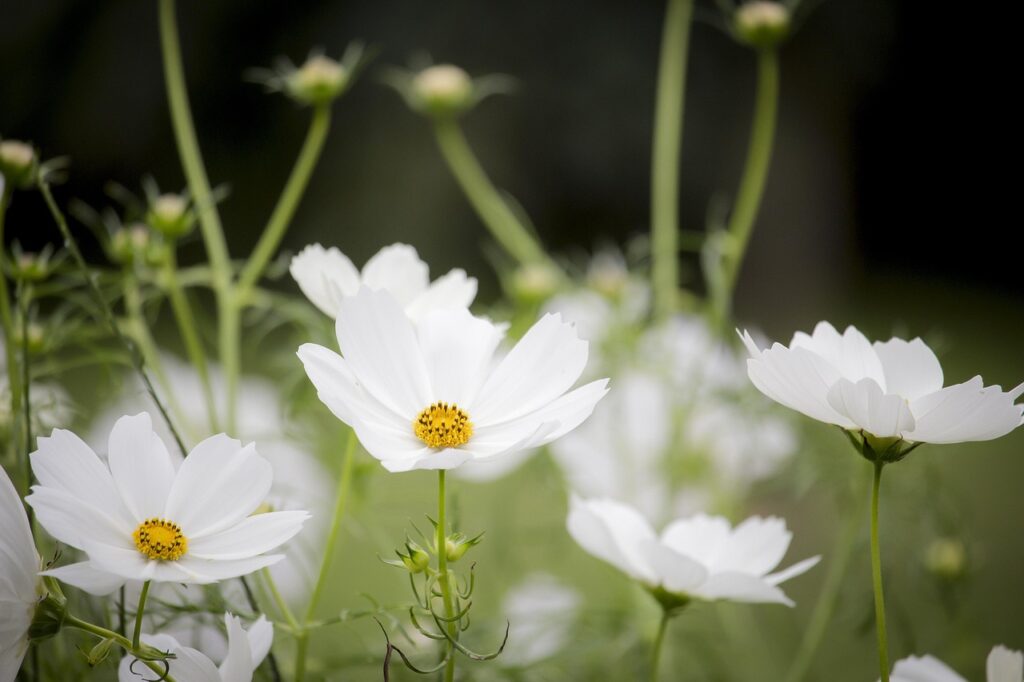
Optimal Temperature for Germination
The optimal temperature for growing Cosmos seeds is around 70-75°F (21-24°C). Ensure that the environment remains within this temperature range to support successful germination. You can use a heating mat to help maintain the desired temperature.
Light Requirements
Cosmos seeds need light to germinate. If necessary, use grow lights or place the seed trays near a sunny window. Once they germinate, provide 12 hours of light a day at minimum. Providing sufficient light at this stage ensures healthy seedling growth.
Time to Germination
Cosmos seeds typically germinate within 7-21 days when provided with the right conditions. Be patient, as germination can vary based on factors like temperature and seed quality. Once the seedlings have several sets of true leaves, you can transplant them into the garden if temperatures are warm.
How to Prepare the Garden Bed for Cosmos

A well-prepared garden bed is crucial for the successful growth of Cosmos plants. Here are step-by-step instructions:
Select a suitable location for growing Cosmos. Cosmos thrives in full sun, so choose a spot that receives at least 6-8 hours of direct sunlight daily. Ensure that it’s well-drained to prevent waterlogging, as Cosmos doesn’t tolerate wet feet. Consider the garden’s aesthetics and the plants’ height when choosing their placement within your landscape.
While Cosmos plants are relatively drought-tolerant once established, they still need regular watering during dry spells, especially when they’re establishing roots. Ensure the garden bed has access to a water source for easy irrigation.
Cosmos plants are adaptable to various soil types, but they prefer well-drained soil. You can improve drainage by incorporating organic matter such as compost or well-rotted manure into the soil. This also enhances the soil’s structure and nutrient content. The ideal soil pH for Cosmos is slightly acidic to neutral, typically ranging from 6.0 to 7.0. You can test your soil’s pH and make adjustments if necessary to create a favorable growing environment for Cosmos.
Hardening Off Cosmos Starter Plants
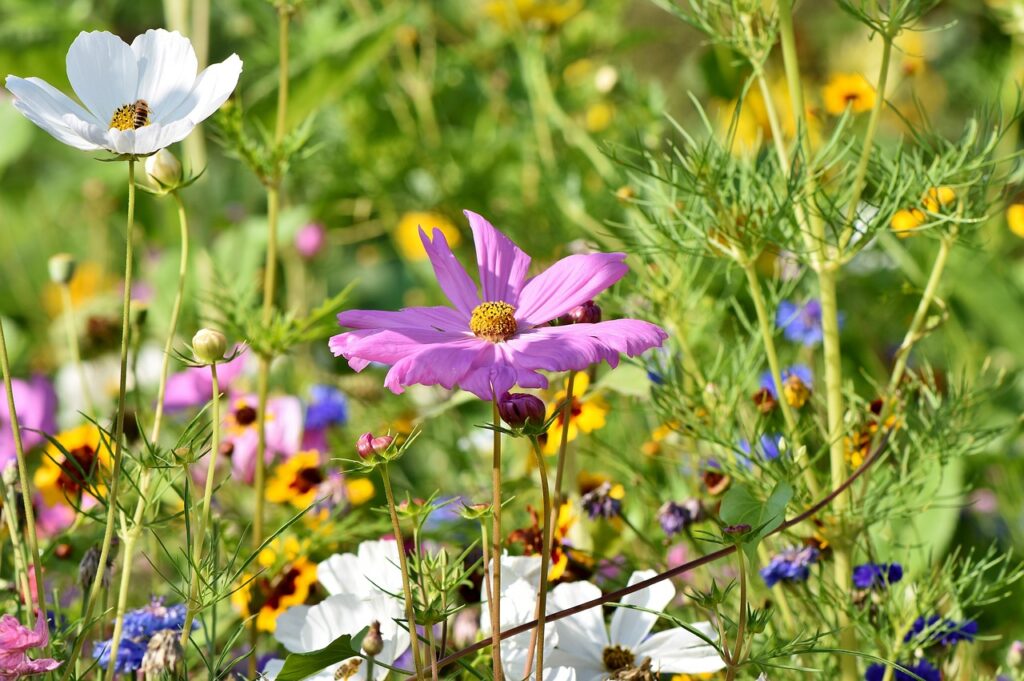
Hardening off is the process of acclimating indoor-grown seedlings to outdoor conditions before transplanting them into the garden. Here’s how to harden off Cosmos starter plants:
Begin the hardening-off process about two weeks before your planned transplant date. Start by placing your growing Cosmos seedlings outdoors in a sheltered location, such as a covered porch or under a tree, for a few hours each day. Choose a mild day to start this process.
Gradually increase the time spent outdoors and expose the seedlings to direct sunlight for a limited duration each day. Over the course of 7-10 days, extend their outdoor time and gradually expose them to full sun. This step helps the seedlings adjust to the increased light levels and temperature fluctuations.
Pay attention to weather conditions and protect the seedlings from extreme heat, cold, or heavy winds during the hardening-off process. Bring them indoors if adverse conditions are expected.
Water the seedlings as needed during the hardening-off period to prevent wilting. The outdoor environment may require more frequent watering than indoors.
Once the seedlings have spent several days outdoors, are acclimated to the conditions, and show no signs of stress, they are ready for transplanting into your well-prepared garden bed.
By following these steps for hardening off, you’ll ensure a smooth transition for your Cosmos starter plants from the controlled indoor environment to the garden’s outdoor conditions.
Planting Cosmos Plants in the Garden
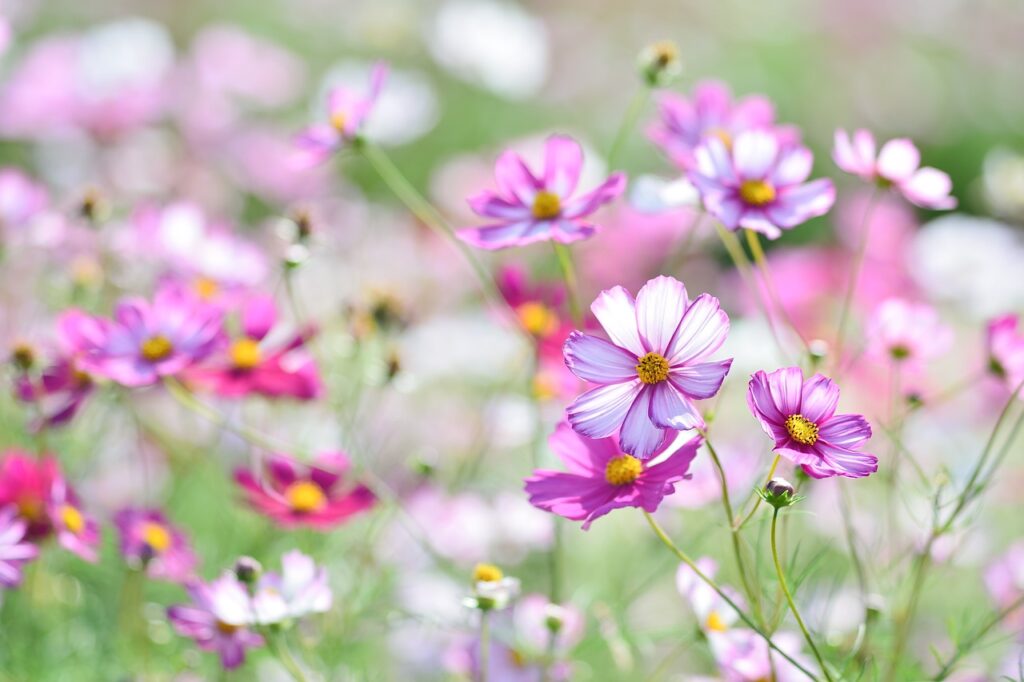
Planting Cosmos in your garden involves several key steps for success. Here’s how to do it:
When transplanting Cosmos seedlings into your garden bed, ensure that they are planted at the same depth as they were in their containers. Typically, this means placing them at a depth of about 1/4 inch below the soil surface. Cosmos prefer not to be buried too deep.
Space your Cosmos plants at least 12 to 36 inches apart, depending on the variety you’re growing. Taller varieties may require more space to accommodate their mature size, so it’s essential to follow the spacing recommendations specific to the type you have.
Applying a layer of organic mulch around your Cosmos plants can help conserve moisture, suppress weeds, and maintain a consistent soil temperature. Use materials like straw, shredded leaves, or compost. Apply the mulch, keeping it a few inches away from the base of the plants to prevent stem rot.
After transplanting, water your Cosmos plants thoroughly to help settle the soil and reduce transplant shock. Provide regular, consistent watering as they establish themselves in the garden. Cosmos are relatively drought-tolerant once established, but they still benefit from consistent moisture, especially during dry spells.
Caring for Your Growing Cosmos Plants
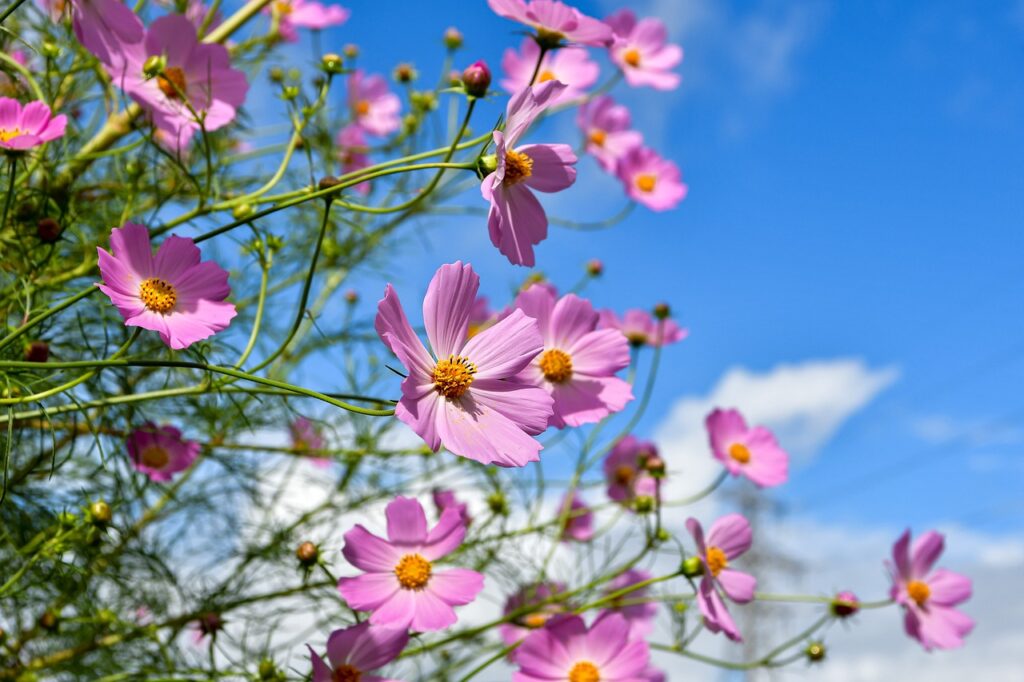
Caring for Cosmos involves several key aspects to ensure their healthy growth:
While Cosmos is drought-tolerant once established, they still need consistent moisture. Water your plants during dry periods, and ensure the soil remains consistently moist but not waterlogged. It’s best to water at the base of the plants to keep the foliage dry and minimize the risk of disease.
Cosmos plants benefit from a liquid fertilizer for flowering plants. Apply a diluted fertilizer every 4-6 weeks during the growing season to support their flowering and overall health. Follow the manufacturer’s recommendations for the specific fertilizer you’re using.
Regular weeding is important to prevent weeds from competing with your Cosmos for water and nutrients. Keep the garden bed free of weeds that may crowd or overshadow your Cosmos plants. A layer of mulch can also help in weed suppression.
Tips and Tricks for Growing Cosmos

When it comes to growing Cosmos, there are several considerations and tips to keep in mind:
Pinching Back
Cosmos plants often do not require pinching back. However, if you want to encourage bushier growth and more abundant blooms, you can pinch back the growing tips when the plants are around 12 inches tall. This encourages lateral branching and more prolific flowering.
Staking or Supports
While many Cosmos varieties are naturally sturdy and may not require staking, taller varieties, especially in areas with strong winds, might benefit from some support. Using stakes or small cages can help keep the plants upright, preventing them from bending or breaking.
Organic Pest Control
To address common garden pests a simple spray of one gallon of water to 1 Tablespoon of castile soap often removes pests.
Organic Disease Management
To prevent and treat common garden diseases like powdery mildew, ensure proper air circulation between plants by maintaining appropriate spacing.
Water at the base of the plants to keep the foliage dry, reducing the risk of fungal diseases. In case of disease outbreaks, you can use organic fungicides like sulfur or copper-based solutions.
Other Tricks
Cosmos are generally low-maintenance, but here are a few additional tips:
Deadhead spent blooms regularly to encourage continuous flowering.
Allow some of the spent flowers to go to seed to encourage self-seeding for the next growing season.
What to Expect After Flowering and in the Winter
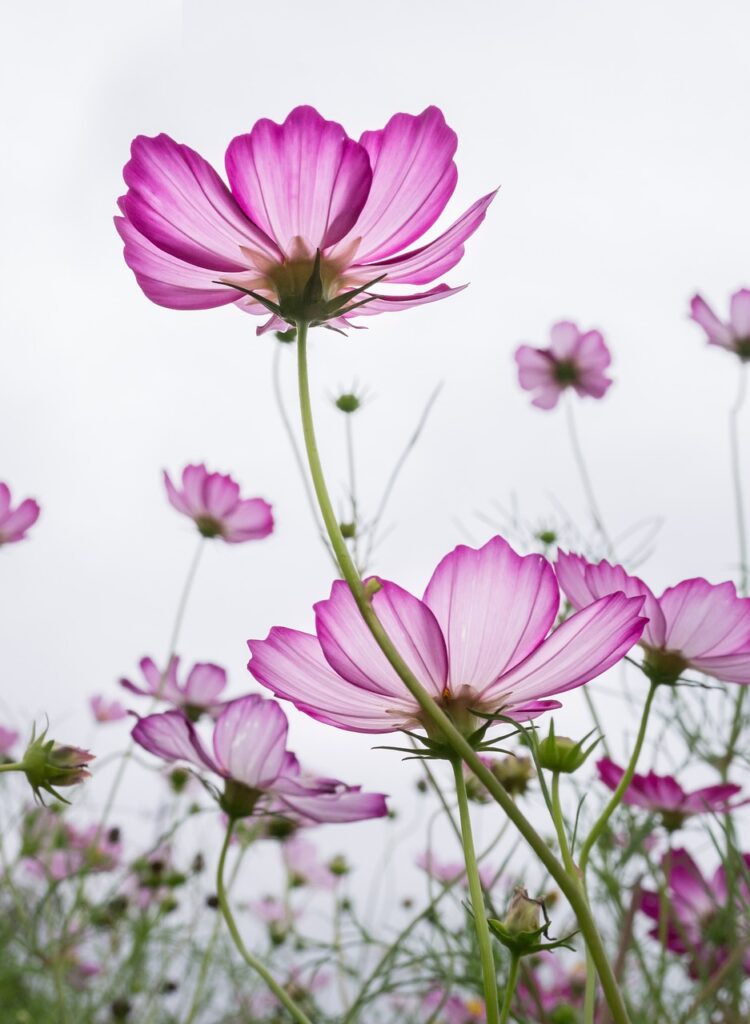
After the stunning display of blooms, Cosmos plants will typically continue to produce flowers well into the fall, providing a late-season burst of color in your garden.
However, as winter approaches and temperatures drop, your growing Cosmos plants will start to decline. The frost will eventually kill the foliage, and the plants will wither.
Will Cosmos Grow Back After Winter?
Cosmos are typically grown as annuals in many regions, which means they complete their life cycle in one year. In fact, even in subtropical and tropical climates, Cosmos have a pre-determined lifespan and will die off, even if the weather stays very warm.
While the parent plant will not grow back, if you allow some of the spent flowers to go to seed and self-sow, new Cosmos plants may sprout in the same area the following spring, provided the conditions are suitable.
Will Cosmos Reseed?
Cosmos are prolific self-seeders. As the flowers fade and the seed heads mature, they will release seeds into the garden bed. These seeds can overwinter in the soil and germinate when conditions become favorable in the following spring.
You can expect volunteers to pop up in the same area or even nearby, creating a natural, effortless renewal of your Cosmos garden.
How to Harvest and Collect Cosmos Seeds
If you want to harvest Cosmos seeds for replanting or sharing with others, follow these steps:
- Wait until the flowers have faded and the seed heads have dried on the plant. The seed heads will turn brown, and you’ll notice the seeds inside.
- Carefully cut the seed heads from the plant using scissors or pruners, allowing them to drop into a paper bag or a container to collect the seeds.
- Once you’ve collected the seed heads, shake or gently tap them to release the seeds into the container. Ensure the seeds are fully dry before storing them.
- Store the Cosmos seeds in a cool, dry place in an airtight container, like a small envelope or a glass jar. Label the container with the seed variety and the date of collection.
Cosmos, with their vibrant and abundant blooms, are a wonderful addition to any garden. With proper care and attention, these lovely annuals can grace your outdoor space with their colors, attract pollinators, and reseed themselves for future seasons. Whether you’re planting them for the first time or preserving their seeds for another year, the beauty of Cosmos continues to bring joy to gardeners year after year.
